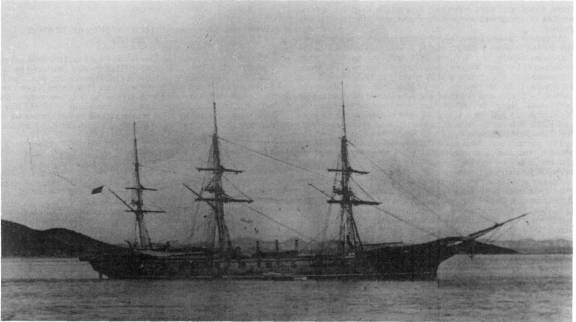|
HMS Bittern (1869)
Seven ships of the Royal Navy have borne the name HMS ''Bittern'', after the bird, the bittern: * was an 18-gun sloop launched in 1796 and sold in 1833. * was a 12-gun brig launched in 1840 and sold in 1860. *HMS ''Bittern'' (1861) was to have been a wood screw sloop A screw sloop is a propeller-driven sloop-of-war. In the 19th century, during the introduction of the steam engine, ships driven by propellers were differentiated from those driven by paddle-wheels by referring to the ship's ''screws'' (propelle .... She was ordered in 1861, but construction was cancelled in 1864. * was a wood screw gunvessel launched in 1869 and sold in 1887. * was an launched in 1897 and sunk in a collision in 1918. *HMS ''Bittern'' was to have been a sloop, but she was renamed before her launch. * was a ''Bittern''-class sloop, launched in 1937 and sunk in 1940. {{DEFAULTSORT:Bittern, Hms Royal Navy ship names ... [...More Info...] [...Related Items...] OR: [Wikipedia] [Google] [Baidu] |
Royal Navy
The Royal Navy (RN) is the United Kingdom's naval warfare force. Although warships were used by English and Scottish kings from the early medieval period, the first major maritime engagements were fought in the Hundred Years' War against France. The modern Royal Navy traces its origins to the early 16th century; the oldest of the UK's armed services, it is consequently known as the Senior Service. From the middle decades of the 17th century, and through the 18th century, the Royal Navy vied with the Dutch Navy and later with the French Navy for maritime supremacy. From the mid 18th century, it was the world's most powerful navy until the Second World War. The Royal Navy played a key part in establishing and defending the British Empire, and four Imperial fortress colonies and a string of imperial bases and coaling stations secured the Royal Navy's ability to assert naval superiority globally. Owing to this historical prominence, it is common, even among non-Britons, to ref ... [...More Info...] [...Related Items...] OR: [Wikipedia] [Google] [Baidu] |
Bittern
Bitterns are birds belonging to the subfamily Botaurinae of the heron family Ardeidae. Bitterns tend to be shorter-necked and more secretive than other members of the family. They were called ''hæferblæte'' in Old English; the word "bittern" came to English from Old French ''butor'', itself from Gallo-Roman ''butitaurus'', a compound of Latin ''būtiō'' (buzzard) and ''taurus'' (bull). Bitterns usually frequent reed beds and similar marshy areas and feed on amphibians, reptiles, insects, and fish. Bitterns, like herons, egrets, and pelicans, fly with their necks retracted, unlike the similar storks, ibises, and spoonbill Spoonbills are a genus, ''Platalea'', of large, long-legged wading birds. The spoonbills have a global distribution, being found on every continent except Antarctica. The genus name ''Platalea'' derives from Ancient Greek and means "broad", refe ...s, which fly with necks outstretched. Species There are currently 14 species divided into three genera ... [...More Info...] [...Related Items...] OR: [Wikipedia] [Google] [Baidu] |
Sloop-of-war
In the 18th century and most of the 19th, a sloop-of-war in the Royal Navy was a warship with a single gun deck that carried up to eighteen guns. The rating system covered all vessels with 20 guns and above; thus, the term ''sloop-of-war'' encompassed all the unrated combat vessels, including the very small gun-brigs and cutters. In technical terms, even the more specialised bomb vessels and fireships were classed as sloops-of-war, and in practice these were employed in the sloop role when not carrying out their specialised functions. In World War I and World War II, the Royal Navy reused the term "sloop" for specialised convoy-defence vessels, including the of World War I and the highly successful of World War II, with anti-aircraft and anti-submarine capability. They performed similar duties to the American destroyer escort class ships, and also performed similar duties to the smaller corvettes of the Royal Navy. Rigging A sloop-of-war was quite different from a civilian ... [...More Info...] [...Related Items...] OR: [Wikipedia] [Google] [Baidu] |
Brig
A brig is a type of sailing vessel defined by its rig: two masts which are both square rig, square-rigged. Brigs originated in the second half of the 18th century and were a common type of smaller merchant vessel or warship from then until the latter part of the 19th century. In commercial use, they were gradually replaced by fore-and-aft rigged vessels such as schooners, as owners sought to reduce crew costs by having rigs that could be handled by fewer men. In Royal Navy use, brigs were retained for training use when the battle fleets consisted almost entirely of iron-hulled steamships. Brigs were prominent in the coasting coal trade of British waters. 4,395 voyages to London with coal were recorded in 1795. With an average of eight or nine trips per year for one vessel, that is a fleet of over 500 colliers trading to London alone. Other ports and coastal communities were also be served by colliers trading to Britain's coal ports. In the first half of the 19th century, the va ... [...More Info...] [...Related Items...] OR: [Wikipedia] [Google] [Baidu] |
Screw Sloop
A screw sloop is a propeller-driven sloop-of-war. In the 19th century, during the introduction of the steam engine, ships driven by propellers were differentiated from those driven by paddle-wheels by referring to the ship's ''screws'' (propellers). Other propeller-driven warships included screw frigates and screw corvette A corvette is a small warship. It is traditionally the smallest class of vessel considered to be a proper (or " rated") warship. The warship class above the corvette is that of the frigate, while the class below was historically that of the slo ...s. See also * CSS ''Alabama'' * USS ''Alaska'' * USS ''Contoocook'' * HMS ''Gannet'', now a museum ship. * USS ''Housatonic'', sunk by the first successful submarine attack. * USS ''Wyoming'' * * Ship types {{navy-stub ... [...More Info...] [...Related Items...] OR: [Wikipedia] [Google] [Baidu] |



